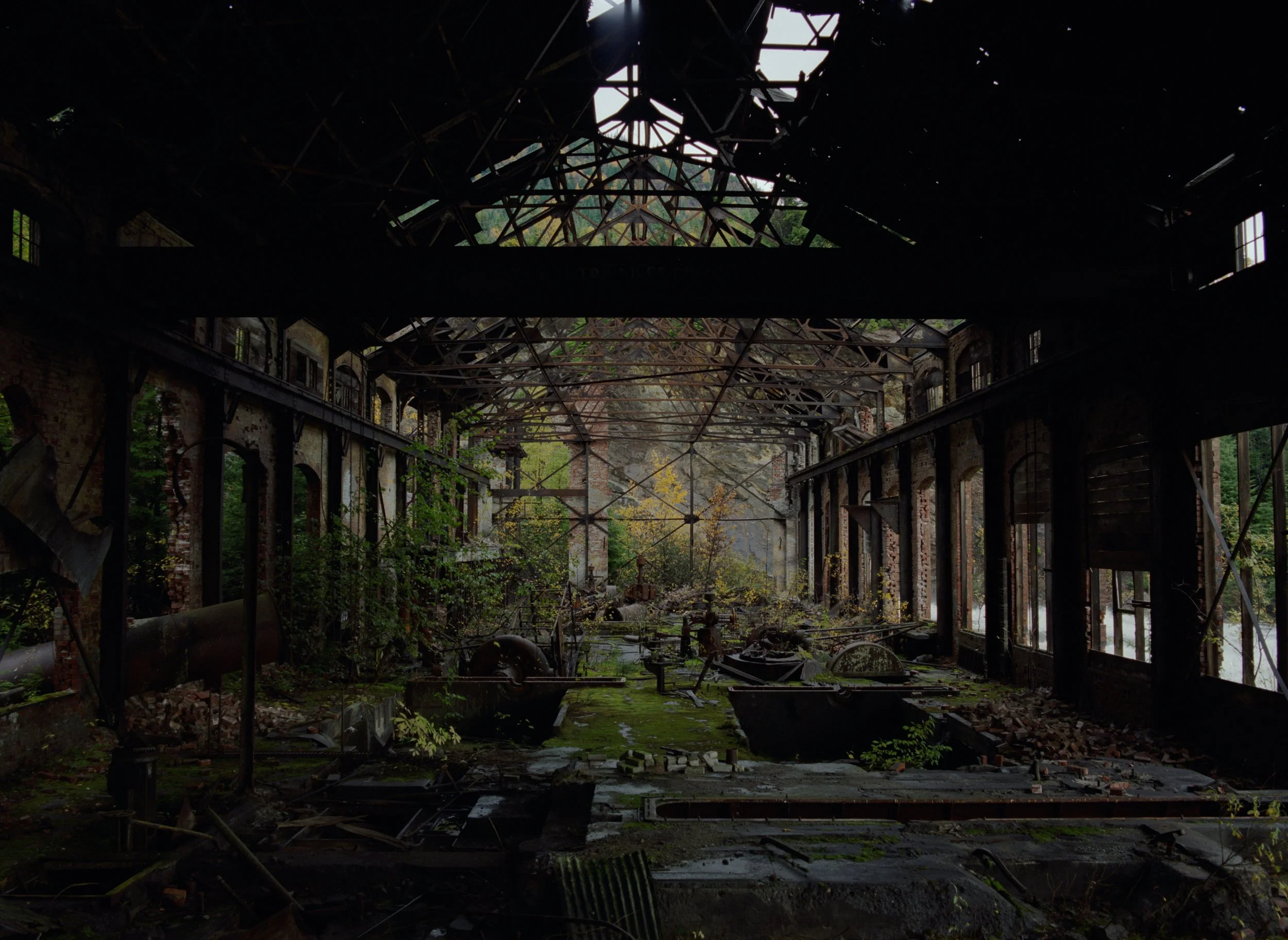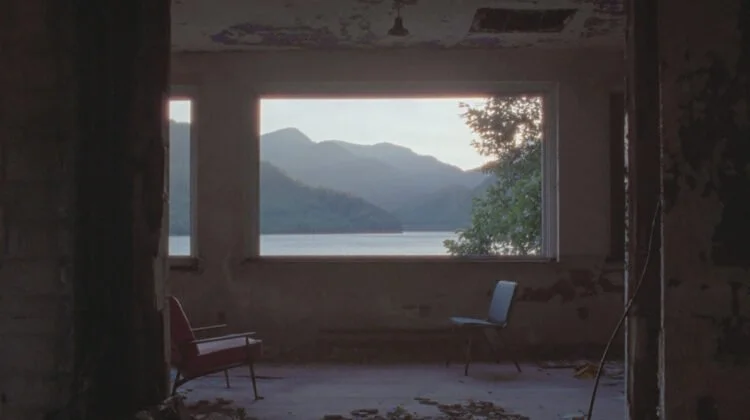Vancouver documentary filmmakers Ryan Ermacora and Jessica Johnson let landscapes speak in Unsettled Settings
The Cinematheque retrospective pays tribute to the duo’s Anyox and other meditative works that explore remote BC sites haunted and scarred by industrial past
Nature takes back a former mining site’s derelict building in Anyox.
Ryan Ermacora and Jessica Johnson
The Cinematheque’s Unsettled Settings: Ryan Ermacora and Jessica Johnson opens with a screening of Anyox and Sharon Lockhart’s NŌ on May 18 at 7 pm, with a discussion with the filmmakers. Anyox screens again May 20 at 8:15 pm and 22 at 6:30 pm. Ermacora and Johnson’s shorts screen May 20 at 6:30 pm and May 22 at 8:30 pm
IN THEIR HAUNTING experimental documentaries, Vancouver filmmakers Ryan Ermacora and Jessica Johnson are drawn to the hidden outer reaches of BC. They travel long distances to landscapes where humans have yanked whatever resources they can from the earth and then abandoned town—leaving behind the scars.
That interest dates back as far as 2015, when the then-SFU School for the Contemporary Arts film students made shorts like “Ocean Falls”, with its hypnotic static shots of coastal BC landscapes through the windows of decaying, abandoned miners’ buildings.
In their first feature-length documentary, 2022’s critically lauded Anyox, they travel way north of Prince Rupert to the titular ghost town that has only two inhabitants left. Their camera lingers on towering heaps of dark-grey slag, looking like the bleak surface of the moon against the distant misty mountains and ocean. The piles are a lasting reminder of the copper-smelting of a mining town that grew there between 1915 and 1935, complete with stores, churches, and schools.
And then it disappeared, amid pollution, the depression, and labour unrest. Acid rain had decimated the local forest. Trailings had poisoned the water. And toxic sulfurous fumes had turned the ground into a tinder box.
Shot in 35mm and 65mm cinematography, the pair’s films feature long silences and little talking; instead, they let the landscapes speak for themselves. In the process, they’ve found a new, poetic language to tackle the intersecting issues of climate crisis and labour—a style without conventional Voice of God narration, talking heads, or imposed narrative arcs.
“We’d always had questions about the history of this place, and particularly this history of resource extraction—and the fact that most towns in BC exist today because of colonial settlements that existed because of resource extraction,” Ermacora begins, speaking to Stir over a video call with Johnson. “And so, as we explored more and more of the province, we started finding these more unknown towns that were resource-extraction hubs, but never actually developed into towns that we know of today. They had a short-lived boom and bust, and then were abandoned because they were no longer profitable.”
The Cinematheque pays tribute to the filmmakers’ decade-long oeuvre with a series that starts this week. Aptly titled Unsettled Settings, it features screenings of Anyox, as well as a program that gathers together several of their individually and collaboratively made shorts around similar themes.
Ermacora and Johnson have known each other since high school in the Okanagan. Each initially went on to pursue other fields—Ermacora, history and international relations; Johnson, archeology. But then a stint living in Berlin, with frequent visits to its art-cinema shrine Kino Arsenal, convinced them to turn their attention to film, and they both enrolled at SFU.
Knowing each other so well, and working together over the years, the pair has developed a unique collaborative relationship. With a background in photography, Ermacora often heads out to a site to take still pictures that the duo then uses for inspiration.
“From there, we’ve always kind of both been pretty involved in everything,” Johnson says. “It’s just very conversational—the research and pre-production is kind of where we figure a lot of things out.”
That deep research process takes a prominent role in Anyox, filled as it is with blueprints of the townsite and scrolling microfiche of old newspaper headlines, long-defunct labour-rights ‘zines, and government documents. In much the same way Johnson and Ermacora pieced together the history of this outpost, so do we. Eventually a deeply unsettling story of union busting, immigrant workers, pay cuts, bunkhouse squalor, environmental disaster, and deportations emerges. All this in a town where the company owns everything, and can inflate grocery prices as easily as it can cut wages.
“It kind of fits into this idea that we're kind of just delivering raw material to the audience,” Ermacora observes. “It’s not refined and polished in this way where the information is presented to you in an educational or didactic sort of mode; it’s more like we've photographed all this raw material in Anyox—the raw material of the mine itself, the material that's been dumped like the slag pile, this kind of historical garbage heap.”
The filmmakers intersperse these archives with a wealth of black-and-white found footage of the mine—labourers made minuscule by the giant smelters, sinister machines, and gaping shafts. Similarly, the two remaining residents of the boat-in-only town work tirelessly to bulldoze away at the gargantuan piles of slag, preparing mining detritus for barges in what looks like a Sisyphean task.
The filmmakers say they lived in the couples’ portable barge dwellings while shooting the piece.
“It was really nice to kind of come home every evening and eat a meal with them and just talk about the day,” says Johnson, who adds the couple—unsurprisingly for two people who live in almost complete isolation—weren’t keen on being the centre of the film. Instead, we watch them from a distance, working and living amid the a coastal landscape that’s by turns strange and beautiful.
In an effect that almost has to be experienced to understand, cinematographer Jeremy Cox’s static shots convey layers of history and the ghosts of the past without needing words. In one held shot of a creek rushing over rocks, the viewer simply feels that haunting memories underlie the pretty picture.
“The historical weight of certain locations can be very intense,” Ermacora explains. “They dumped chemicals straight out of the smelter into that creek.”
He tells a story about that location that never made its way into the film. “We read about a boy who was living in Anyox who fell into that creek, and no one was able to save him because it was so toxic that if somebody had gone into it, they also would have died,” he relates. “And so the idea that that creek was so poisoned that you couldn't even save someone who had fallen in was just so disturbing. Standing in that exact spot had so much weight to it.”
The pair say they drew stylistic inspiration from early cinematography, when entire films might be shot within a static camera frame. They’re also flipping the idea of “B roll” in conventional documentaries, where landscape shots serve as brief establishing shots.
“We're interested in holding onto those things,” Ermacora says. “So that rather than the landscape image just being like a signifier of a place, you can really think about that image—think about what's potentially taking place there. We try to work, within the structure of our films, where you're given a piece of information and then later you might see the landscape in which that information was discussed in archival documents or through an interview. And then you kind of consider that landscape with those concepts in mind. Or vice versa, where you consider a landscape without knowing anything about it, and then you learn maybe a piece of information later on, and then you still have that lingering image of that landscape in your mind and you can reconsider it once again.
“It’s playing with those ideas of contemplation, and allowing images to linger for a long time,” he adds. “Something that we've talked about a lot is the idea of watching an image and thinking about it in one way and then potentially getting bored and zoning out and your mind drifting away. And then the image is still on screen for so long that you return to it again, a second time, with kind of a new thought process.” In Anyox, that holds true of an extended shot of an industrial ruin being reclaimed by forest moss and vines, or of the yellowed trailings pond that branches out toward a forest. It’s almost like the memories of the place start to surface while you gaze at them.
Together, these unsettled settings capture what Ermacora calls a micro-history that speaks metaphorically to the wider challenge of resource extraction, very much as it exists a century later—in BC and across the globe.
An ghost town’s abandoned house in the short film Ocean Falls.
Johnson reveals that the pair is in the midst of making a documentary around a more positive labour force: the oyster farmers on Cortes Island. It’s a spot that’s not quite as remote as usual for this duo, and an area of work that’s more sustainable—although, they allow, the subject ties inextricably into ocean warming and its implications.
For now, they’re finding more than enough inspiration in their home province for compelling—and unsettling—cinematic contemplation.
“We had a prof at one point who I remember telling us that with this type of work, dealing with landscape and labour, ‘You'll be doing this for about 10 years. And then you'll find something else,’” Ermacora recalls. “And we're basically approaching that 10-year mark. So I'm very curious if she's correct: we've done it for 10 years, and now we're either going to find like a new kind of language, or will we just keep doing this indefinitely?”















